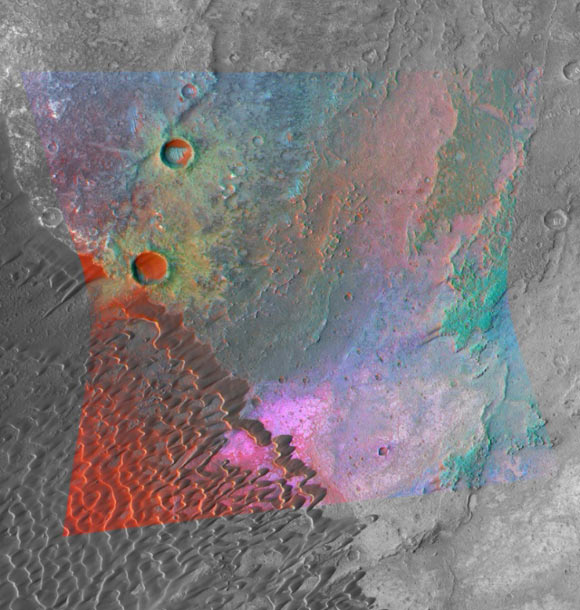U.S. researchers reporting in the journal Nature Geoscience have found strong evidence that the Red Planet has granitic rocks.

Distinctive feldspar-rich composition of Nili Patera, the Syrtis Major volcano, Mars. Image credit: NASA / JPL / JHUAPL / MSSS.
For years Mars was considered geologically simplistic, consisting mostly of one kind of rock, in contrast to the diverse geology of Earth. The rocks that cover most of Martian surface are volcanic rocks called basalt.
But earlier this year, NASA’s Mars Curiosity rover found soils with a composition similar to granite, a light-colored, common igneous rock.
The new study bolsters the evidence for granite on Mars by using remote sensing techniques with infrared spectroscopy to survey a large volcano called Syrtis Major that was active for billions of years.
Syrtis Major is dust-free, making it ideal for the study. Most volcanoes on Mars are blanketed with dust, but this volcano is being sand-blasted by some of the fastest-moving sand dunes on Mars, sweeping away any dust that might fall on the volcano. Inside, the research team found rich deposits of feldspar.
The location of the feldspar and absence of dark minerals inside the ancient volcano provides an explanation for how granite could form on Mars.
While the magma slowly cools in the subsurface, low density melt separates from dense crystals in a process called fractionation. The cycle is repeated over and over for millennia until granite is formed.
This process could happen inside of a volcano that is active over a long period of time, according to the computer simulations.
“We think some of the volcanoes on Mars were sporadically active for billions of years. It seems plausible that in a volcano you could get enough iterations of that reprocessing that you could form something like granite,” said study lead author Dr James Wray from the Georgia Institute of Technology.
This process is sometimes referred to as igneous distillation. In this case the distillation progressively enriches the melt in silica, which makes the melt, and eventual rock, lower density and gives it the physical properties of granite.
“These compositions are roughly similar to those comprising the plutons at Yosemite or erupting magmas at Mount St. Helens, and are dramatically different than the basalts that dominate the rest of the planet,” said co-author Josef Dufek, also from the Georgia Institute of Technology.
______
Bibliographic information: Wray JJ et al. Prolonged magmatic activity on Mars inferred from the detection of felsic rocks. Nature Geoscience, published online November 17, 2013; doi: 10.1038/ngeo1994







